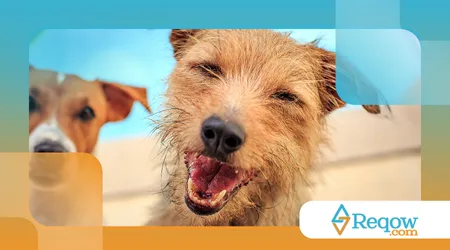Tips for Keeping Apartment Dogs Active and Happy

Keeping Apartment Dogs Active and Happy is a common challenge for many urban tutors.
Advertisements
Living in smaller spaces doesn't mean a less vibrant life for your four-legged friend, however. On the contrary, it just requires a little more creativity and dedication to your routine.
The Big City Challenge and Canine Welfare
The busy routine and limited square footage can easily lead to boredom.
Bored dogs often develop destructive or anxious behaviors. A balanced pet needs constant mental and physical stimulation.
Prioritizing quality over quantity of activity is crucial.
Advertisements
A focused, interactive twenty-minute walk is worth more than an hour of distracted walking. Think of the apartment as a spa of well-being.
Smart Strategies for Physical Exercise
We don't need a huge backyard to burn off dog energy.
Using daily walks wisely is the first line of defense against a sedentary lifestyle. Explore different routes to stimulate your sense of smell.
Fetch games indoors, or in a safe hallway, are excellent.
Use stairs, if available, for short sessions of climbing up and down, strengthening muscles. It's important to adapt the amount of exercise to your dog's age and breed.
Turning the Apartment into an Amusement Park
The vertical space of the apartment is an underrated resource.
Use it! Teach your dog to jump over low, safe obstacles, such as firm cushions. Remember, safety always comes first.
Interactive toys that roll and bounce unpredictably are great.
They encourage chasing and rapid movement in a confined space. Don't let inertia creep into your pet's life.
The Power of Mental Stimulation
A mentally tired dog is often calmer than a dog that is just physically tired.
Environmental enrichment is the master key to keeping apartment dogs active and happy.
Treat-dispensing toys, for example, turn mealtime into a challenge.
Read more: The importance of playing with your dog every day
They force the dog to "work" for food, simulating foraging in nature. This keeps the dog engaged for a long time.

Training and New Skills
Short obedience training sessions are high-impact mental exercises.
Teaching new tricks or reinforcing old commands requires concentration and focus from your dog. Constant learning keeps him engaged.
Find out more: How to teach your dog to behave in pet-friendly restaurants
Instead of just giving them the food bowl, hide small portions in different rooms.
Your dog will have to use his sense of smell and memory to find them. This makes for an excellent mental "treasure hunt."
Routine, Socialization and Emotional Well-Being
Dogs thrive on predictable routines. Regular feeding, walking, and playtimes provide emotional security.
Predictability reduces separation anxiety and uncertainty.
Socialization, even in apartments, is vital. Taking your dog to safe parks to interact with other dogs is essential. Canine interaction is a language of its own that needs to be practiced.
The Human-Canine Connection: How to Keep Apartment Dogs Active and Happy
Your involvement is the main factor in your dog's happiness. Simply providing toys isn't enough. You need to dedicate time for joint play and quality affection.
++ Games that help with training and strengthen the bond
After all, our relationship with them isn't like an app running alone in the background. It requires interaction. It's possible. keeping apartment dogs active and happy with strong ties.
Dogs are social creatures that mirror their owner's mood. If you're present and engaged, they will be too.
Golden Data and Tips for Tutors
According to a survey conducted by Royal Veterinary College in the UK, published in 2023, dogs that engage in mental and physical enrichment activities for at least 30 minutes daily, in addition to regular tours, present a reduction in 40% in stress levels and destructive behaviors. This is an important fact to consider.
| Activity | Recommended Minimum Duration (daily) | Main Focus |
| Free Smell Tour | 45 – 60 minutes | Physical Exercise and Olfactory Stimulation |
| Mental Enrichment (Interactive Toys) | 15 – 20 minutes | Concentration and Problem Solving |
| Training Sessions/Tricks | 10 – 15 minutes | Focus and Mental Discipline |
| Interactive Games (Tug of War, Fetch) | 20 – 30 minutes | Fast Energy Bonding and Expenditure |
Innovation in Play
Use an old towel to wrap treats or kibble. Tie a knot and have your dog unroll it.
It's a challenge of scent and dexterity that requires much more mental effort than it seems. This simple technique helps keeping apartment dogs active and happy.
Think of canine energy like water in a river. If the river is dammed, the water stagnates and can overflow destructively.
But if we channel this energy into different channels—exercise, training, play—it flows in a healthy and controlled way. This is the perfect analogy for routine.

The Recipe for a Satisfied Pet and Keeping Apartment Dogs Active and Happy
There is no magical mystery in keeping apartment dogs active and happy.
The secret lies in consistency, diverse stimuli, and, above all, love. Caring for a dog in an urban environment requires intentionality.
Are we giving our best friends the quality attention they deserve, or just the attention we have left over?
This is the question every owner should ask themselves. The reward for this effort is a calm, healthy, and, above all, radiantly happy dog.
Frequently Asked Questions
Do small dogs need less exercise?
Not necessarily. Small breeds like Jack Russell Terriers have extremely high energy levels and require a lot of activity. Size isn't the only indicator of exercise needs.
How many daily walks are ideal?
In general, three short to medium walks (morning, afternoon, and evening) are ideal for most apartment dogs.
The most important thing is that one of these tours is longer and focuses on free smelling.
How can I stop my dog from destroying things out of boredom?
The key is adequate mental and physical enrichment. If your dog gets 90 minutes of focused activity per day and interactive toys, the chances of destruction decrease dramatically.
An active dog is not a bored dog.
Can I replace the walk with playing at home?
No. Walks fulfill essential functions: physiological relief, olfactory exploration (the dog's "newspaper"), and socialization. Playing at home is a complement, but not a substitute.
Other sources: Active and happy dogs
